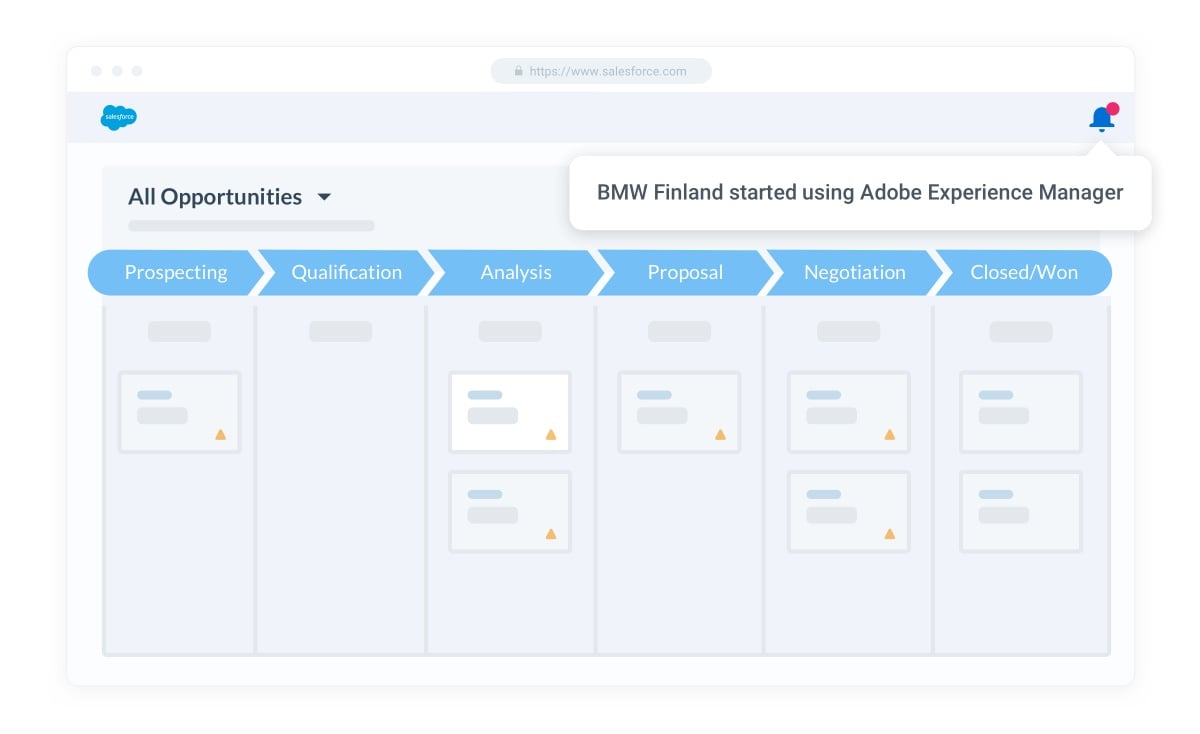Level Up Your CRM Strategy With These Best Practices
When you buy a coffee machine or dishwasher, or even a car, reading the user's manual is a great idea to make the most of all the features.
When you invest in a CRM platform, your strategy is your user's manual. It ensures that the technology delivers on its intended purpose, leveraging customer and prospect data to achieve business outcomes. It helps you align multiple customer-facing teams to use one platform, maintaining a centralized database across your sales organization.
For most companies, a CRM is the first and usually the most significant investment they make in terms of sales technology. There's a caveat, though. It'll take more than the best CRM platform to win. You'll need a system that your team knows and wants to use, and for that, you'll need a rock-solid CRM strategy.
To find out how to properly deploy a CRM system—and become a salesperson's best friend—I chatted with a couple of experienced CRM consultants and asked them how to create a bulletproof strategy. Here's what they told me.
Start with a vision: Figure out what you need to fix
A CRM is not a plug-and-play tool. Implementing a CRM system—or migrating to a new one—is a severe challenge for a sales organization. It requires a well-thought-out plan and the commitment to a project several weeks long.
Harri Krokfors, who works as a Customer Success Executive at Biit, a Finnish consulting and technology company focused on Salesforce products, argued that the most common reason for a failed CRM project is unclear goals and use cases.
 Harri said, "The first thing a company must do is define clear goals for the project. What is the main objective you're trying to achieve with a new CRM? Is it to boost new sales, cross-selling, low churn? When the goals and use cases are clear to everyone, the implementation project is often hassle-free. I usually recommend the use of agile methods."
Harri said, "The first thing a company must do is define clear goals for the project. What is the main objective you're trying to achieve with a new CRM? Is it to boost new sales, cross-selling, low churn? When the goals and use cases are clear to everyone, the implementation project is often hassle-free. I usually recommend the use of agile methods."
As a result, CRM projects are born out of very different needs. The most common goals are:
- The integration of sales and marketing activities to draw further insights on inbound leads.
- Increasing the return on investment of marketing activities.
- Making lead flow more efficient.
- Gaining insights into sales performance and sales pipeline.
- Being able to forecast revenue more accurately, and hence, decide where to invest.
- Building a systematic process to compile customer data instead of relying on salespeople to log data into various systems.
- Higher customer retention thanks to a better view of the customers' needs.
- Better collaboration between teams with clearer handover between salespeople to build a more holistic customer experience.
The end goal will define your strategy's scope and how you can make the most out of the technology. CRM platforms have matured into incredibly versatile and capable systems with countless features to organize and manage all of your customer-related information. However, those endless capabilities can be distracting and lead to the moderate implementation of the software. That's why you should never lose sight of the problem you're trying to solve.
Data collection: Inject the correct information into your CRM
Any CRM worth its salt will undoubtedly improve and support your sales and marketing efforts. By systematically using a CRM, your teams will track and manage all interactions and communication with prospects and customers. However, CRMs are only as valuable as the information they store. Poor CRM data will hurt performance.
By design, CRMs are meant to collect data, so I asked Jesper Riedel, Director at LeapForward, what type of information a CRM should store.
Jesper explained, "Companies need to think about their own processes first, and only then, consider the data they need. Before deciding on the data, I recommend that you audit your customer-related activities with a special focus on sales, marketing, and customer success teams. Start by looking at how these teams work today, what systems they use. Find out if there are any repetitive, redundant tasks like data input."
In his view, "Once you know how to best support your teams, you'll easily see the data you need. I would also recommend keeping all customer data relevant for sales and marketing in the CRM. It's of utmost value to be able to see how a customer that has now grown big, started their journey with a company."
Similarly, Harri pointed out that if one wants to be really effective in sales, a CRM platform must include as much information as possible about prospects, customers, partners, contacts, activities, signals, etc. "The wider the view of the customer and their activities at different stages of the customer path, the better. For example, account managers need a comprehensive picture of the selected customer's strategies, goals, and context to properly analyze the customer's situation and implement optimal activities to develop the customer's operations," said Harri.
Sync everything to the CRM
Recently, LeapForward surveyed dozens of companies in Denmark to analyze how they use CRM platforms. One of their findings was that 32% of CRM users admit that the lack of data synchronization between systems is a frequent challenge.
The abundance of sales tools requires that data is perfectly synchronized between the different systems. By syncing all your data, you'll reduce manual work. As Jesper said, "Take a stand and ensure there is no need for sales reps to enter the same data in multiple systems."
As a result, your CRM system will be a central location where you organize and manage all of your customer-related information. To achieve this, you want to sync all your data to your CRM. For Jesper, there shouldn't be such a thing as sales reps having to enter the same data across multiple systems because otherwise, mistakes will happen. As we argued before, salespeople shouldn't update the CRM.
Jesper explained: "When you make such a strategic decision, you should analyze where data will primarily live. Take this example. In HubSpot, you might create and enter a deal of an amount of 1 million DKK. But what makes more sense is to pull actual invoiced revenue from the ERP and have it visible in HubSpot. This way, the salesperson can see the status in one view. In this case, data primarily lives in the ERP, and then is pushed by one-way sync to HubSpot."
"Here's another example from my own experience related to quota attainment," Jesper continued. "We implemented a CRM (MS Dynamics) to handle all the leads. It worked great, but when my salespeople acquired a new customer, they were asked to go to a separate form and enter the same data again. The customer success team was cutting corners because entering the data again made it easier for them. In the long run, my sales team wasn't very motivated to keep the CRM updated because, after all, what's a salesperson's biggest motivation? Quota attainment."
Those strategic decisions extend beyond the sales tech stack. Jesper added: "The point is to simplify your setup but not cut any corner that could make the CRM less relevant for daily users. There are tons of great tools out there that allow you seamless synchronization between systems, like Zapier. But before doing that, you first need to design the best possible sales process, then think how the CRM will support that process, and finally, you want to work on your data and systems design and integration."
👉 Essential reading: 3 Easy Steps To Integrate Your CRM Platform With A Company Information Provider
Everybody onboard: Getting your team to use a CRM
It's not an unusual problem: salespeople don't love using a CRM. They often see it as an irritating tool that requires extra time spent on entering data. Or worse, they see it as just another way for their bosses to keep track of their work.
Your sales team's reluctance to use your CRM will severely limit its power. The best way to convince salespeople to use the CRM is to show them how they'll benefit from using the CRM.
Both consultants agreed that a CRM that runs on fresh, accurate data would make it easier for salespeople to understand its benefits, paving the way for a successful CRM strategy.
Harri pointed out, "We must remember that the system is for the users, not the other way around. Easy access to important data and insights is necessary. To remove clutter, you want to delete all unnecessary fields, so the CRM is a quick and easy-to-use tool."
In a similar vein, Jesper said, "The CRM will be a salesperson's best friend when it provides them with relevant customer insights so that they can gain deeper knowledge on their accounts. It is also important to look at any opportunity for sales automation. If you can create automated workflows that free up sales reps' time to spend more time with customers, you'll surely get your team to use the CRM more. For example, ensure there's no need for sales reps to enter the same data in multiple systems."
Pro tip: Facilitate a data-driven sales process
Harri recommends paying particular attention to the reporting capabilities of CRM platforms. "Focusing on analytics is quite worthwhile, as it significantly simplifies the seller's daily life, for example, by telling how to increase the closing probability of a sales opportunity or which leads to focus on first. You should also watch how long it takes to do basic activities and fix overly complex and time-consuming workflows. In particular, any kind of facilitation in the early stages of the sales process is important, so pay special attention to this."
Bottom line, you'll need to gain buy-in from the end-users—your sales, marketing, and customer success teams. Engage them to actively develop the system and build the tool they want to use. Failure to get them excited will result in resistance, poor usage that could blow up your CRM strategy.
Ready, set, launch
People—generally—don't like change. The rollout of a new CRM strategy will certainly disrupt your teams' habits and routines. It doesn't have to happen overnight, though.
Jesper's advice was to "identify quick wins that immediately eases the day of a salesperson. Look for sales automation opportunities. Automate boring, repetitive tasks so sales reps can spend more time with customers."
Harri agreed. "I can't underline enough that a CRM needs to be built from the user's perspective, and that's the salesperson. The better the system serves their sales efforts, the better the system will be used—and the more sales will increase. Salespeople get frustrated if workflows don't match reality. There cannot be the same process for customer acquisition and key account management, for example. To increase CRM adoption, I recommend launching a few basic rules so that data stays in order. Any customer-related conversation should be conducted through the CRM. This way, the right habits will gradually be built, and the CRM will become an indispensable tool and part of a salesperson's routines."
Jesper added, "It's important to make the CRM the main system for salespeople. For that, companies should ensure that KPIs and bonus payouts should be tightly linked to the data in the CRM. Such setup will give reps a larger incentive."


